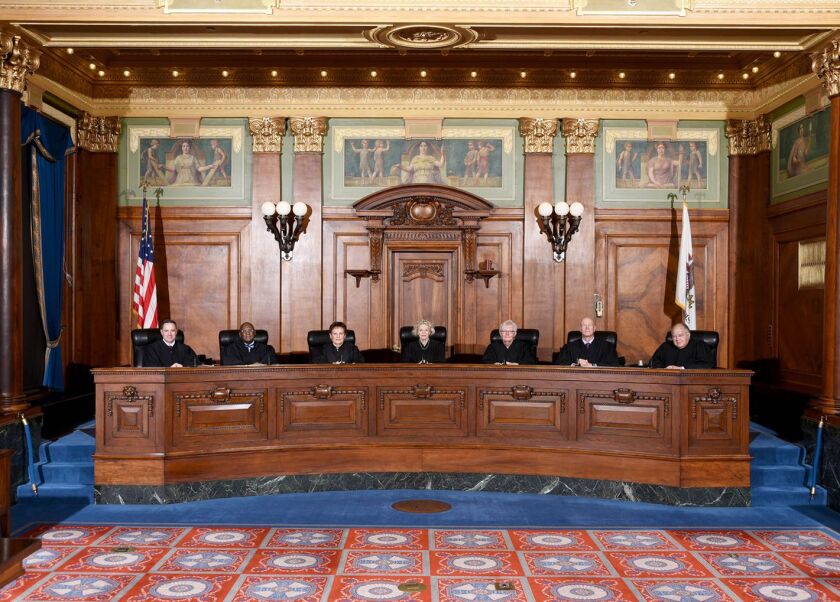A little more than five months after Democrat Thomas Kilbride became the first state Supreme Court justice in Illinois history to fail to win retention, Democrats are redrawing the boundaries of the high court’s judicial districts — for the first time in nearly 60 years.
Republicans, who flooded the airwaves last year with attack ads against Kilbride that branded him Mike Madigan’s “favorite judge,” say that’s no surprise, calling the majority party’s proposal “the latest example of the extraordinary lengths the corrupt political class will go to keep control of power.”
“This is a brazen abuse of our judicial system and nothing more than political gamesmanship with what should be an independent court, free of corrupt influence,” a spokesman for the state’s Republican Party said in a statement.
Democrats in the Legislature unveiled their plan Tuesday to reshape the state’s Supreme Court districts using data from the American Community Survey, hours ahead of their first public hearing on proposed legislative maps released earlier.
The decision to redraw the lines was made to reflect population shifts over the years, which have caused large fluctuations among the existing court districts, Democrats say.
“This map is about equal representation in the state’s most important court,” state Rep. Lisa Hernandez, D-Cicero, chair of the House Redistricting Committee, said in a statement. “As we strive for all to be equal before the law, we must ensure we all have an equal voice in choosing those who uphold it.”
The boundaries for the Illinois Supreme Court districts haven’t been redrawn since 1963 — though Republicans attempted to change the lines in 1997 with their Judicial Redistricting Act before it was ruled unconstitutional.
Under the Democrats’ newly proposed maps, the number of residents in the Supreme Court’s Second, Third, Fourth and Fifth districts will be “substantially equalized to better reflect the population and demographic shifts that have occurred in the state of Illinois over the course of the last sixty years,” according to a news release on the proposed judicial boundaries.
Joe Hackler, the spokesman of the Illinois Republican Party, cast doubt on that.
“Today’s announcement of the redrawing of the Illinois Supreme Court map is the latest example of the extraordinary lengths the corrupt political class will go to keep control of power,” Hackler said. “For the first time in the state’s history, a Supreme Court justice was removed from the Court because of his ties to the Democrat machine.
“Now, in an effort to maintain their stranglehold on the Supreme Court and thwart much needed reform, that same corrupt political class is rigging the maps to stay in power, redrawing the map for the first time in fifty years.”
A spokeswoman for Illinois House Speaker Emanuel “Chris” Welch said she couldn’t say whether Kilbride’s loss influenced the new map, repeating that the proposed boundaries were drawn to reflect population shifts.
State Rep. Jason Barickman said dropping the Supreme Court maps Tuesday afternoon with no advance notice “flies in the face of transparency.”
“I only learned about this a few minutes ago because I read it on a blog,” said the Bloomington Republican. “For all of the hearings that have existed, there’s been zero discussion on this and then we find out that the Democrats are now introducing [Supreme Court] maps.”
State Rep. Avery Bourne likened the released maps to proposals to add members to the U.S. Supreme Court.
“[Democrats] are clearly using the Madigan playbook in the Illinois redistricting process, but I think it’s really disappointing that they’re using the Nancy Pelosi court packing agenda in Illinois,” said Bourne, R-Morrisonville.
Under the proposed map, the Third District that Kilbride once represented — which currently stretches from the state’s eastern edge to its western boundary — would be condensed to a smaller land area while the Fourth District would also shift.
Under the current map, the Fourth district, currently represented by Justice Rita Garman, stretches horizontally across the state. Under the proposed map, it would take up much of the western portion of the state, including some of the land mass that’s part of the current Third District.
Kilbride’s failure to win retention last year, after two decades on the state’s top court, was an embarrassment to Madigan, the former Illinois House speaker who was then also head of the Illinois Democratic Party, which helped fund the state Supreme Court justice’s unsuccessful campaign.
On the other side, committees formed ahead of the November election, including Vote No Kilbride and Citizens for Judicial Fairness, to oppose Kilbride’s bid and block Democratic Appellate Judge Judy Cates from winning an open seat in the Supreme Court’s’ 5th Judicial District. Attack ads linked both Kilbride and Cates to Madigan.
Citizens for Judicial Fairness spent over $5.6 million alone on mailers, digital ads and phone and text messages to oppose the two judicial candidates, records show.
Days after the November drubbing, Democratic U.S. Senators Dick Durbin and Tammy Duckworth, as well as Gov. J.B. Pritzker, conceded that Republicans had successfully used the politically damaged speaker to “hurt our ability to get things done” and called for Madigan to step down as chair of the Illinois Democratic Party.
Politically wounded by the ComEd scandal, Madigan eventually did relinquish the party reins, also giving up his bid to remain speaker and his House seat, closing out a political career spanning half a century.








